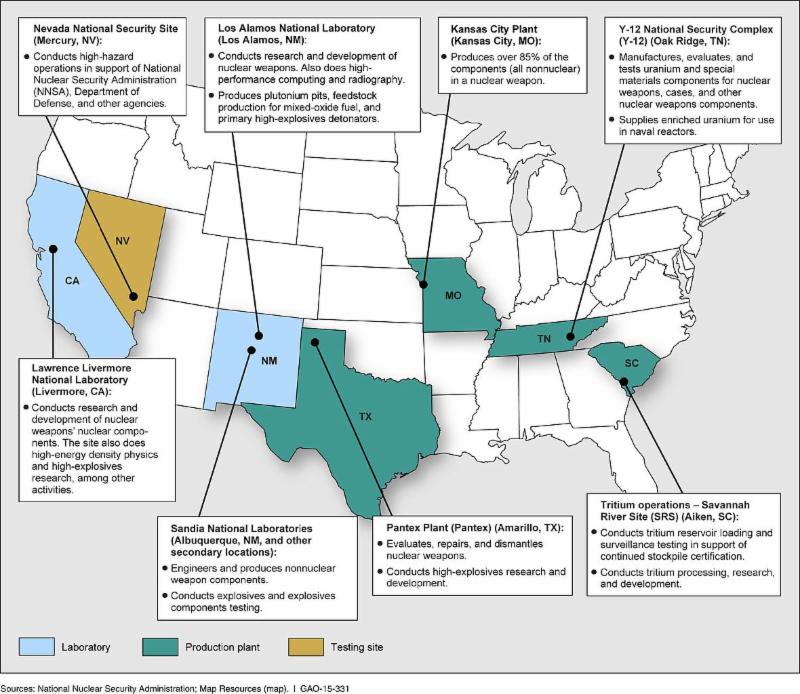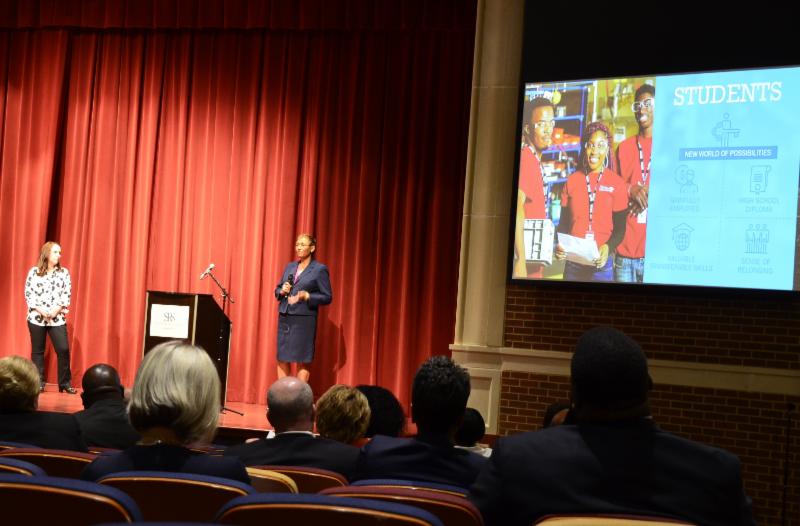In the Pits
 Each nuclear weapon in the U.S. arsenal contains a "pit," a hollow shell of plutonium clad in a corrosion-resistant metal, which is surrounded by chemical explosives. When the weapon is detonated, the explosives compress the pit into a supercritical mass and a fission chain reaction is triggered. The National Nuclear Security Administration (NNSA) has the responsibility to ensure that the nuclear arsenal is safe and reliable.
Recent editorials, like the one found in
The Aiken Standard, and similar articles found on
Huntington News have indicated that NNSA may be conducting a review to determine which DOE sites might be appropriate for location of production of plutonium "pits," the core of nuclear weapons.
At a public hearing in Santa Fe on June 7, the NNSA's associate administrator for safety, infrastructure and operations James McConnell also disclosed that NNSA is now quietly studying whether to keep plutonium pit operations at Los Alamos. Options being considered include upgrading the facilities there or "adding capabilities or leveraging existing capabilities elsewhere in the country, at other sites where plutonium is already present or has been used." Active NNSA sites that fit that description include the Savannah River Site (SRS) in South Carolina, the Pantex plant in Texas and the Nevada National Security Site. The NNSA expects to complete its analysis by late summer.
The mere mention of SRS in relation to NNSA's "pit" mission should not come as a surprise. Back on January 4, 2000, Secretary of Energy Bill Richardson signed a Record of Decision, which identified SRS as the location for building three key plutonium facilities. One of those was MOX but the other two included a Pit Disassembly and Conversion Facility, which was to disassemble the plutonium pits from old weapons and convert the resulting metal into an oxide powder of acceptable quality to the commercial nuclear utilities and an Immobilization Facility to blend and immobilize plutonium oxide with ceramic material. (Go
here to see an article from The Augusta Chronicle in 1998.) Also in September 2002, NNSA issued a notice of intent to prepare an environmental impact statement (EIS) for a big new pit production facility called the Modern Pit Facility (MPF), with a proposed capacity of 125-450 pits/yr. This facility was estimated to cost $2-4 billion and would be built at one of five sites, one of which was SRS.
Of course, with the exception of MOX, none of these new NNSA missions materialized at SRS. But there are reasons why SRS continues to be in the plutonium pit mission discussion and the most recent editorial (see link above) succinctly identified some of those. SRS has the workforce that possesses incredible technical skill to handle such missions. It is a place where some of the most technologically advanced work in the nation is taking place, and SRS would be up to the task of producing plutonium pits if asked.
|
Manufacturing & Education Connections
 Local educators sent a clear message: If you want our students to have real-world experiences before entering the workforce, give them internships and apprenticeships.
With that the room of over 90 erupted in applause as big name businesses connected with guidance counselors, teachers, principals and school board members during Manufacturing & Education Connections held June 14 at the Augusta KROC Center.
The SRS Community Reuse Organization hosted the first-ever event to help educators in Georgia and South Carolina address the hard truth that at least 3.5 million jobs will open nationwide by 2025 but that only 1.4 million of those jobs will actually be filled, according to the U.S. Department of Labor. Why? An overwhelming skills gap, including basic skills that can't be learned from a book, like teamwork, pride and punctuality.
"We need to make educators aware of the modern manufacturing careers available locally, and we want manufacturers to understand how educators are working to develop future employees," said Dr. Lisa Palmer, Chair of the SRSCRO Regional Workforce Committee and Vice President of Economic Development at Augusta Technical College. "Our goal is to foster stronger partnerships that prevent an overwhelming skills gap locally."
No doubt, partnerships between industry and education have proven successful.
Reaching Potential Through Manufacturing is one example that was
 highlighted at the event. RPM - a partnership between Textron Specialized Vehicles and the Richmond County School System - helps students at risk of not graduating make up lost ground toward a high school diploma while earning income and real-world experiences.
Several other businesses in the immediate area see the value of putting young people to work, although most attendees admitted that more must be done. Those companies include MTU America, which builds diesel-powered engines from its Graniteville, S.C. plant; and Barnwell, S.C. based Swiss KRONO USA, which manufactures laminate flooring.
 Manufacturing & Education Connections also focused on Best Practices throughout the SRSCRO region, including Columbia County's Students in Business program, SouthernCarolina Initiatives, National Manufacturing Day and STEM Premier, a social media platform that connects students, colleges and employers.
The idea for Manufacturing and Education Connections was born out of the Regional Workforce Summit hosted by the SRSCRO in 2016. The event served as a pilot program involving the manufacturing sector. The SRSCRO is considering hosting similar events for other industry sectors such as cyber security and healthcare.
To read feedback and ideas from the participants about stronger manufacturing and education connections, click
here.
|
WORC Continues
 As the Workforce Opportunities in Regional Careers (WORC) grant program moves into its second year, 218 scholarships have already been awarded in twenty-two different programs of study, across 5 local colleges and universities.
Michael Christianson is one of the WORC scholarship students at the
 University of South Carolina Aiken. He has chosen to return to college after serving in the U.S. Air Force and commented that the WORC scholarship has helped him afford college as he prepares for a new career. Michael has been selected to participate the 2017 Research Experience for Undergraduates at the Savannah River Ecology Laboratory. He will graduate with a BS in Biology in December 2017.
Other students across the SRSCRO region are developing skills needed by the nuclear industry with assistance from the WORC grant program - a partnership between the SRSCRO, regional colleges and universities, the Department of Energy Office of Environmental Management (DOE-EM) and the National Nuclear Security Administration (NNSA). WORC was established to strengthen the local workforce pool needed to support DOE-EM and NNSA missions, particularly in the Savannah River Site region. WORC builds on the DOE-EM funded Advancing Nuclear Skills Regionally (ANSR) program that established new nuclear training certificate and degree programs locally.
In May 2017, the grant program received approval for $1M of funding from DOE-EM and NNSA for a second year to support student scholarships, recruitment and retention strategies in fields of study relevant to the missions at SRS.
WORC academic partners in South Carolina are: Aiken Technical College, University of South Carolina Aiken and University of South Carolina Salkehatchie. WORC academic partners in Georgia are: Augusta Technical College and Augusta University. The SRSCRO serves as the fiscal agent for WORC.
|
|
|
|
Spotlight
2017 Southeastern
Summer Nuclear Institute

 Some educators traveled 190 miles to take part in the Southeastern Summer Nuclear Institute (SSNI) held June 20 - 22, 2017. The one-of-a-kind Institute offers an exclusive opportunity to learn about nuclear science and the nuclear industry from experts in the field through tours, speakers and hands-on activities. Sixteen educators took part in the third annual event organized by the Citizens for Nuclear Technology Awareness (CNTA) and hosted on the campus of the University of South Carolina Aiken.
Middle and High School teachers from Greenville and Estill, SC joined with others from the greater Atlanta and Augusta, GA areas to tour Plant Vogtle, the Savannah River Site, the Savannah River National Laboratory and Augusta University's nuclear medicine facilities. They heard from Captain Kevin Byrne, Commanding Officer, Naval Nuclear Power Training Command, who traveled from Charleston, SC to join participants for dinner and discussion.
"Participants this year were very engaged leading to lively discussions during the event. They expressed interest in maintaining contact with CNTA and other SSNI participants," said Dr. Jim Marra, CNTA Executive Director. "I am hopeful that participants take back our message to their students and encourage their colleagues to participate next year."
SSNI is sponsored by nuclear employers and others, including the SRSCRO's Nuclear Workforce Initiative to promote nuclear education and workforce development in the Southeastern United States.
SSNI Information is available
here.
|

What would summer be without juicy, sweet watermelon? It's everyone's favorite summer fruit, or is it? Did you know that the watermelon isn't even a fruit?
1. Not only does it quench your thirst, it can also quench inflammation that contributes to conditions like asthma, atherosclerosis, diabetes, colon cancer, and arthritis.
2. Over 1,200 varieties of watermelon are grown worldwide.
3. Watermelon is an ideal health food because it doesn't contain any fat or cholesterol, is high in fiber and vitamins A & C and is a good source of potassium.
4. Pink watermelon is also a source of the potent carotenoid antioxidant, lycopene. These powerful antioxidants travel through the body neutralizing free radicals.
5. Watermelon is a vegetable! It is related to cucumbers, pumpkins and squash.
6. Early explorers used watermelons as canteens.
7. Watermelon is grown in over 96 countries worldwide.
8. In China and Japan watermelon is a popular gift to bring a host.
9. In Israel and Egypt, the sweet taste of watermelon is often paired with the salty taste of feta cheese.
10. Every part of a watermelon is edible, even the seeds and rinds.
11. According to Guinness World Records, the largest watermelon ever grown was grown in Arkansas by Lloyd Bright and weighed 268.8 pounds! The record was set in 2005 at the Hope Arkansas Big Watermelon Contest.
12. Watermelon producers in America grow more than 4 billion pounds of watermelon annually.
13. Jason Schayot is an expert watermelon seed spitter. He holds the world record for watermelon seed spitting at 75 feet 2 inches, set in 1995.
14. The Japanese grow square watermelon. How? They place square glass boxes around a growing fruit so it becomes square as it grows. The Japanese like them because they're small and don't roll around. They fit neatly in a refrigerator. The downside? These watermelon cost about $82!
15. A watermelon will not grow in your belly if you eat the seeds. In fact, the seeds are actually quite nutritious with high levels of magnesium, zinc and protein. Chew the seeds before swallowing for optimum nutrition.
|
|